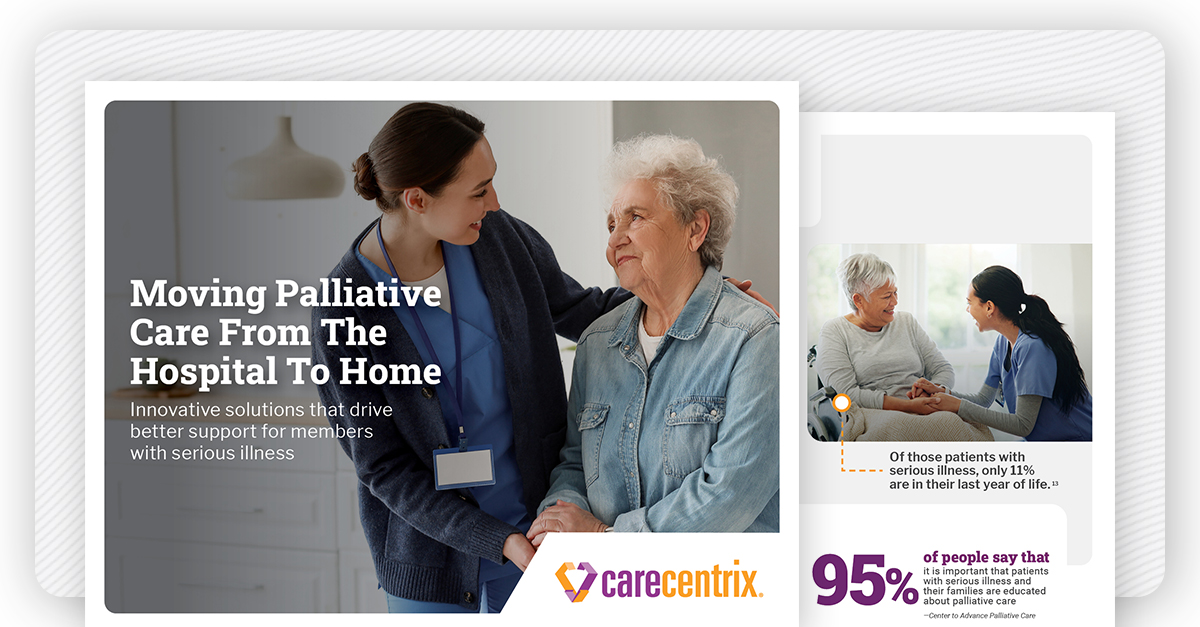Enrollment in Medicare Advantage (MA) has nearly doubled over the past decade, and a new study shows that overall, at least 364 plans will take advantage of CMS’s more flexible MA policies in 2020 by providing certain types of supplemental benefits. Expanded MA supplemental benefits is largely tied to CMS’s updated guidance allowing plans to cover anything that has “a reasonable expectation” of improving or maintaining the well-being of beneficiaries with chronic conditions.
This is an opportunity for payers to improve care for seriously ill members living at home by providing supplemental benefits that improve health but aren’t connected directly to clinical care. vary by plan and may include home-based palliative care, home care, non-medical transportation, nutrition programs, home modifications and support for caregivers. These fall outside traditional Medicare benefits but may enable members to remain in their own homes, reduce social isolation and lead longer, healthier lives.
High receptivity for these supplemental benefits is highlighted in a recent study demonstrating that 37% of enrollees in large MA plans have significant needs related to both medical and social services. These individuals are more likely to report having limited financial resources, low levels of education, social isolation and poor health.
The urgency of expanding Medicare coverage to better meet the needs of its beneficiaries is emphasized by the fact that five percent of Medicare’s sickest and most complex beneficiaries account for more than half its spending.
Payers will need to overcome the challenges of identifying high-need beneficiaries based on a combination of clinical and non-clinical issues, rather than simply relying on claim history, in order to better target their services and facilitate implementation of the CHRONIC Care Act provision that allows plans to offer non-health supplemental benefits.
At this juncture, and as an increasing number of members with advanced illness are choosing to remain at home, case managers can turn to industry partners with community-based palliative care (CBPC) solutions for support in more timely and accurate identification of appropriate enrollees as well as the implementation of these programs.
Overcoming Challenges
Barriers to rolling out CBPC benefits include 1) operational challenges, such as establishing contracts with community-based organizations that can offer meals, transportation and other services, 2) ensuring services are available in rural areas, and 3) understanding where to target new benefits for most effective use of limited resources. Plans also require evidence for how the benefits they design will impact clinical care quality, the health and quality of life of members and overall health care costs.
Case Examples
Meet Irene
Irene is an 80-year old woman with cancer who lives alone and wants to remain in her apartment for as long as possible. She is quite frail but mobile and able to cook and bathe on her own. In assessing her environment, a team of CBPC experts determined that she would benefit from home modifications, including extra handrails in her stairwell and bathroom so that she could use both arms to stabilize herself. This provision enables Irene to avoid preventable falls and injuries that could have led to hospitalization.
Meet Earl
Earl is a 92-year old man with a heart condition and asthma. He lives with his daughter who takes care of him, but because she is on a fixed income, she is unable to afford an air conditioner for the hot summer months. In this case, the palliative care clinicians determined that it would benefit Earl and his daughter to provide an air conditioner to help relieve his asthma symptoms and avoid potential hospitalization for his condition.
Partnering with Innovative Palliative Care Solutions to Optimize Supplemental Benefits
Turn-Key Health’s process-driven, structured CBPC approach – Palliative Illness Management (PIM) – utilizes predictive analytics to identify and engage members like Irene and Earl, who are living at home and struggling with multiple clinical and non-clinical issues. PIM’s four-step approach sets the foundation for gaining insight into the member’s and caregivers’ understanding of the illness, as well as medical needs and potential interventions:
- Engaging with members and caregivers in the home to more accurately identify the scope and intensity of problems
- Developing a palliative plan of care to address gaps in care and other priority needs
- Coordinating outreach to community resources, such as making contact with neighbors, friends, family members, religious groups and community organizations that can assist
- Following up to ensure that the problems impacting the member’s day-to-day life and quality of care are resolved
Using structured assessments and methodology, PIM’s highly trained professionals develop a trusting relationship with members and their families during home visits and address both clinical and non-clinical issues to prevent avoidable sub-optimal care, injuries and hospitalizations.
As a result, care provided for those with serious or advanced illness and living at home is more compassionate, less costly for members and payers and is sustainable for an enhanced member and caregiver experience.





